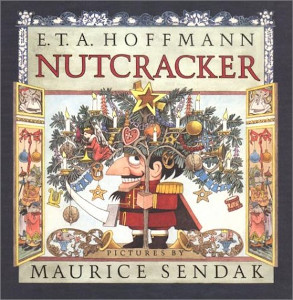Nutcracker

Author:
E. T. A. Hoffman
Illustrator:
Maurice Sendak
Foreword:
Maurice Sendak
Original title:
Nussknacker und Mauserkonig
Original language:
German
Translator:
Ralph Manheim
Publication:
1984 by Crown Publishers
Genre:
Fairy Tales, Fiction, Folk Tales, Holiday
Pages:
120
Current state:
Basic information has been added for this book.
It has been read but content considerations may not be complete.
Book Guide
Search for this book used on:
The tale of Nutcracker, written by E.T.A. Hoffmann in 1816, has fascinated and inspired artists, composers, and audiences for almost two hundred years. It has retained its freshness because it appeals to the sense of wonder we all share.
Maurice Sendak designed brilliant sets and costumes for the Pacific Northwest Ballet's Christmas production of Nutcracker and has created even more magnificent pictures especially for this book. He has joined with the eminent translator Ralph Manheim to produce this illustrated edition of Hoffmann's wonderful tale, destined to become a classic for all ages.
The world of Nutcracker is a world of pleasures. Maurice Sendak's art illuminates the delights of Hoffmann's story in this rich and tantalizing treasure.
From the dust jacket
To view an example page please sign in.
Resource Guide
Episode 70: Why Read Fairy Tales?
Released in 2020 by The Literary Life
Available formats: Streaming Audio
Length: 1 hr. 29 min.
View on the The Literary Life site
"Angelina Stanford and Cindy Rollins tackle the topic of fairy stories, discussing the what, why and how of reading them. Angelina shares the distinctive characteristics of fairy stories in contrast to other types of stories, such as myths. They deal with the question of whether fairy tales are 'escapist', the influence of the Grimm brothers scholarly work on interpreting fairy stories, and allowing the story to unveil its deeper truths without forcing meaning onto it.
Angelina gives an illustration of how to see the gospel messages in fairy tales by talking us through the story of Sleeping Beauty. She refutes the ideas that fairy tales are about human romance or are misogynistic. She also highlights some of the Enlightenment and Puritan responses to fairy tales that still linger with us today. Cindy and Angelina also discuss some common concerns such as the magical, weird, or scary aspects of fairy tales. Angelina also makes a distinction between folk tales, literary fairy tales, and cautionary tales."
Find This Book
Search for this book used on:



